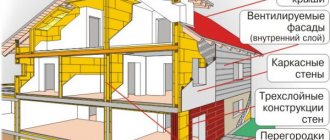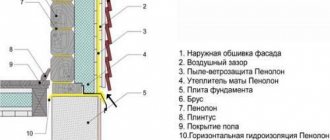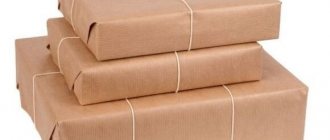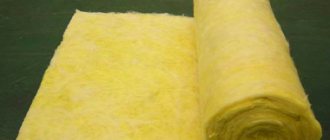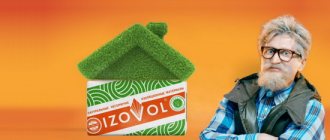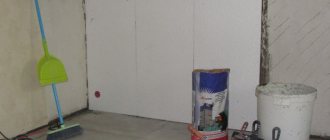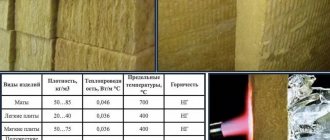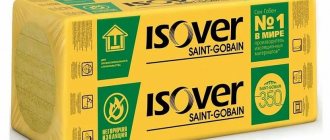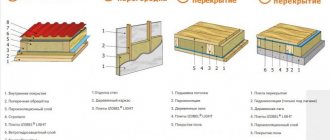Preface . Today there is a large selection of heat and sound insulating materials on the market. Manufacturers today offer modern materials for thermal insulation with various characteristics and purposes. One of them is the mineral wool manufacturer ISOROC. In this material we will look at ISOROK insulation, the technical characteristics of the material, its purpose and features of application in construction.
The Russian company ISOROK specializes in the production of modern insulation materials based on mineral wool for insulation of residential premises. German and Austrian shareholders installed Swedish equipment at the Tambov plant and introduced European technologies. As a result, a new insulation of European quality ISOROC based on natural components has appeared on the construction market.
Features of ISOROC mineral wool
Thermal insulation materials ISOROC
ISOROC mineral wool is made from natural materials, consists of fibers with air between them, and has a low thermal conductivity coefficient. The material has a high melting point, is a fire-resistant material, prevents the spread of fire and can be successfully used for installation in a boiler room or in fire-fighting structures.
The company's product range includes insulation materials of various densities made from environmentally friendly materials. Heavy slabs, thanks to the strong connection of fibers, can withstand quite significant loads and are often used to insulate flat roofs. Treatment with water-repellent compounds during production increases the water-repellent characteristics of Isorok insulation.
The disadvantages of the material include deterioration of thermal insulation when wet; during installation, it is necessary to carefully vapor-waterproof the structure. It is also possible for light grades of cotton wool to slip off vertical surfaces over time. The product range includes more than 20 brands of ISOROC insulation, manufactured in rolls and slabs, which differ in their basic properties and purpose.
Plates and mats
Many consumers may not understand why the company made such a division, because all of the above models are also slabs. The thing is that Izolight, Isorok and other products are heat-insulating board materials that are produced according to the technical specifications developed by the manufacturer itself. Plates and mats are produced according to state standards. Their quality is controlled by the requirements of government agencies.
For example, PP-80 slabs are manufactured in accordance with GOST 9573-2012, mats - in accordance with GOST 21880-2011. All these materials can be used to insulate any surface: horizontal, vertical and inclined. They are used for thermal insulation of brickwork and facades with the installation of wind protection on ventilated structures. Plaster cannot be applied to them. You can pour screed over them only with surface protection with waterproofing material.
ISOROC insulation: technical characteristics
The sizes of the plates can be different, but the most important characteristics are: thermal conductivity 0.033 – 0.07 W/(m K); density 40 – 150 kg/cub.m.; compressive strength 10 – 55 kPa and water absorption 1 – 5%. In this case, an increase in density leads to an increase in strength and a decrease in thermal conductivity. In the absence of waterproofing, moisture can fill the space between the fibers and increase thermal conductivity.
Izorok insulation brands can be divided into several groups depending on their purpose.
Izolight, Izolight-Lux and Izolight-L are used to insulate surfaces without putting any stress on the thermal insulation.
Isovent and Isovent-L are intended for sound insulation of ventilated facades and insulation under siding.
Izoflor, Izokor-S and Izokor-K can work under load and are used for thermal insulation of floors.
Izoruf N, V, NL are intended for insulation of flat roofs with and without cement screed.
Isofas is used for thermal insulation of facades of private houses with plastering of the surface.
IZOVOL Acoustic “Noise Protection”
Izovol “Protection from Noise” on a basalt basis is one of the most effective sound-absorbing building materials in the class.
Mandatory quality control of each slab ensures consistently high acoustic and consumer properties of this product. Research and development of the IZOVOL company have shown that frame partitions made of plasterboard sheets on a metal or wooden frame are the most effective way to protect against noise both during construction and reconstruction of buildings and structures for various purposes!
The randomly directed structure of basalt fibers of IZOVOL stone wool is the best barrier to sound waves and completely prevents their propagation, which contributes to a comfortable stay in the room and has a beneficial effect on people’s well-being.
IZOVOL materials are indispensable when arranging acoustic interior partitions and coverings of all types. The use of IZOVOL products ensures ideal comfort indoors, thanks to the unique properties of highly efficient insulation, its low density and fibrous structure, improves the functional characteristics and hygiene of the premises, and, consequently, improves the quality of life in general.
Application area:
• for sound insulation of walls, ceilings, partitions, floors during construction;
• for sound insulation of air ducts and ventilation systems;
• for sound insulation of industrial equipment.
Specifications:
| Length, mm | 1000 |
| Width, mm | 600 |
| Thickness, mm | 40-250 interval 10 |
| Flammability, class | NG |
| Packaged in m3 | 0.24 (for slab thicknesses of 50mm and 100mm) |
| Vapor permeability, mg/m•H•Pa, not less | 0,3 |
| Thermal conductivity, W/(m•k) | 0.035 |
Price
RUR/pack
476
from
Application of ISOROC mineral wool
Areas of application for Isorok roll insulation are thermal insulation of horizontal surfaces without load, thermal insulation of sloping roofs, pipelines and equipment. Isorok is superior to polystyrene foam in vapor permeability, fire and environmental safety, and is slightly inferior to foam plastic in thermal conductivity and resistance to moisture. The materials have sufficient durability.
Table. Technical characteristics of ISOROC insulation materials
Main advantages
The Izorok line of insulation, which has a large number of varieties, is characterized by the following indicators:
- low level of thermal conductivity, allowing to reduce the cost of heating the facility;
- good sound insulation;
- high strength indicators;
- resistance of insulation boards to deformation and other mechanical influences;
- good water-repellent qualities;
- fire resistance and environmental friendliness of the product.
Another attractive aspect of this material is its resistance to aggressive environments.
Resistance to fungal formations is explained by the inorganic origin of the starting material, and fire resistance is due to the presence of fire retardant additives in it.
Tips for choosing ISOROK insulation
Universal thermal insulation ISOLIGHT is a slab of basalt moisture-resistant wool. ISOLIGHT is used in residential and industrial structures as non-load-bearing thermal insulation. Area of application: partitions, external and internal walls, floors, roofing, basements.
ISOVENT universal insulation – non-flammable slabs made of moisture-resistant stone wool. They are used for thermal and sound insulation of surfaces and enclosing structures of all types (vertical, horizontal, inclined). A prerequisite is the presence of an air gap (ventilated facades under siding).
Universal insulation ISOFLOOR is a non-flammable, moisture-resistant mineral wool in the form of slabs. Provides reduction of heat loss in concrete and reinforced concrete structures, self-leveling and electric water floors, wall sandwich panels and similar structures in residential buildings.
history of the company
The Izorok enterprise was founded quite recently - in 2000. In order to begin production of a new generation of insulation materials, its management had to reconstruct the old Tambov plant. Insulation materials have been produced at this enterprise before. Their production began back in 1982. During the reconstruction, German technologies were used, as well as equipment from the famous Swedish company Ungers. This made it possible to start producing much higher quality materials.
And today the company uses only innovative equipment, as well as the highest quality and safest materials. This is precisely what became the main reason for the more than successful competition of insulators of this brand with other products, including those from many well-known foreign companies.
Thermal insulation tasks
For a good thermal insulation material, important properties are low thermal conductivity (the ability to transfer heat), low water absorption (the ability to absorb and retain moisture in the pores in direct contact with water), fire safety (the ability of the material to withstand high temperatures without ignition, damage to the structure, strength, etc.). d.), environmental safety (harmlessness to humans).
The lower the thermal conductivity coefficient, the less heat passes through the building envelope: in winter the room cools down slowly, and in summer it heats up slowly, therefore, you can save on heating or cooling it
Therefore, first of all, when choosing insulation, you need to pay attention to its thermal conductivity coefficient under operating conditions in a particular region (according to SNiP 23-02-2003 “Thermal protection of buildings” for the Nizhny Novgorod region, these operating conditions are designated by the letter “B”). The lower the water absorption. insulation, the better, because wet, wet insulation conducts heat well
This is due to the fact that the air pores of the insulation are filled with water, and water conducts heat much better than air. In addition, very wet insulation can simply freeze and “turn into a piece of ice”; in this case, there is no question of any thermal insulation. Water absorption is characterized by the amount of water that a dry material absorbs when kept in water, divided by the weight of the dry material. Therefore, when choosing insulation, pay attention to what this parameter is (it is indicated in the technical documentation for the material). When comparing materials from different manufacturers belonging to the same class of insulation, it is better to choose the one with less water absorption (this parameter is measured as a percentage).
The lower the water absorption of the insulation, the better, because wet, wet insulation conducts heat well. This is due to the fact that the air pores of the insulation are filled with water, and water conducts heat much better than air. In addition, very wet insulation can simply freeze and “turn into a piece of ice”; in this case, there is no question of any thermal insulation. Water absorption is characterized by the amount of water that a dry material absorbs when kept in water, divided by the mass of the dry material.
Therefore, when choosing insulation, pay attention to what this parameter is (it is indicated in the technical documentation for the material). When comparing materials from different manufacturers belonging to the same class of insulation, it is better to choose the one with less water absorption (this parameter is measured as a percentage).
The fire safety of the material is determined according to GOST 30244 “Building materials. Test methods for flammability" and GOST 30402 "Building materials. Test methods for flammability", SNiP 21-01-97 "Fire safety of buildings and structures". All materials are assigned a flammability group G4, G3, G2, G1 - flammable or NG - non-combustible materials. Of course, it is better to choose insulation belonging to the NG group for a frame or any other house.
In addition, the insulation should not be subject to significant shrinkage. Otherwise, during operation, cracks will form in place of the insulation, and the thickness of the material itself will decrease, which leads to the formation of cold bridges and an increase in heat loss.
Insulation for frame houses is made from a variety of materials and comes in various forms. These can be soft mats, which, for ease of transportation, are rolled into rolls or slabs, packed in several pieces in plastic film.
Membranes
The use of building thermal insulation materials when insulating the walls of buildings helps to increase the thermal resistance of the structure and reduces the fire hazard. In addition, with their use it is possible to enhance sound insulation, improve the characteristics of humidity conditions, and also reduce the load on the base of the building. Izorok materials have long gained great popularity among consumers.
In the construction of modern buildings, Isorok insulation materials are often used, but for ease of operation they require good protection. For this purpose, membrane materials with a specialized structure have been developed, thanks to which the products provide good thermal insulation characteristics. Membrane films are highly durable, resistant to rupture, and have excellent performance characteristics. Working with them is convenient and quite easy - this helps to significantly reduce the time required for production and installation work.
Membrane materials are used as decorative coatings that protect the thermal insulation structure. Available in the form of sheets rolled into a roll. This form provides more convenience in installation of products.
ISOROC FOIL-HI, -LHI materials are produced in the form of three-layer membranes with high vapor-permeable properties. They are used in construction work to create wind protection, water protection in insulated pitched roofs, and when constructing a ventilated facade. The product is highly resistant to ultraviolet rays. The use of the membrane is recommended in conjunction with insulating materials of the Isorok brand - in this way it is possible to significantly improve their heat-protective characteristics and increase the service life of the structure.
The ISOROC FOIL-VB variety is an active vapor barrier membrane that can protect the insulating layer from water vapor that escapes from the living space to the outside. Its use has many advantages. The use of this material, if the technology is followed correctly, will help the thermal insulation remain stable, and the service life of building structures increases several times.
Both retail and wholesale supplies of building materials are possible.
Application: protective and decorative coatings
Production technology
Due to the fact that foamed PE appeared on the construction market quite a long time ago and is in great demand among users, a large number of manufacturers began to produce PE. In order to standardize the process of producing material, a common production technology was adopted, which all companies and firms must follow.
First of all, it should be noted that the manufacturing technology of foamed polyethylene consists of several stages. Moreover, some of them require the use of gas, while others do without it.
The general production scheme includes the following elements:
- extruder;
- compressor for gas supply;
- cooling line;
- packaging.
For the direct production of the material, specially designed LDPE and HDPE granules are used (various elements based on them can also be used). In some cases, primary raw materials can be combined with so-called regranulates. At the same time, it should be borne in mind that foamed polyethylene can also be produced from recycled materials. At the same time, it must meet certain requirements, namely, its composition must be free of any impurities, and the raw material itself must have an average molecular weight and be uniform in color.
We recommend: Why do we need a heat exchanger in a heating system?
Penoizol production
Equipment for the production of penoizol
If you look at the penoizol production process, all its stages are quite simple. There is no need to incur large costs for equipment and manufacturing, and a small list of elements is used in the process. The technology includes the following stages:
- The components that form the basis of the solution are mixed in the container: foaming agent, catalyst and water. At the same time, prepare a solution in a second container - it is filled with urea-formaldehyde resin. After this, the mixture from the second container is combined with the first under the influence of compressed air.
- Mix all the elements so that the result is something like a soufflé. Here we get just liquid penoizol, which can already be used in further construction.
- To make hard sheets, you need to pour the resulting composition into molds and leave for some time to harden. Usually 30-40 minutes are enough for this (sometimes you will have to wait up to 3 hours). The time period depends on the size of the material and its shape.
- After the sheets are ready, they need to be cut into several parts. If it is necessary to improve some of the characteristics of the sheets, they are additionally coated with a special solution.
- After this, the finished product is packaged and prepared for storage.
Reviews about the material
“Izorok” is an insulation material about which consumers have mostly positive opinions. The possibility of using it for insulation of building envelopes with increased fire hazard is noted. “Izorok” is completely non-flammable. In addition, the materials of this brand have earned positive reviews due to their durability. It is impossible to tear such sheets and slabs during the installation process.
“Izorok”, reviews of which are mostly very good, has one more advantage. Consumers like the lack of shrinkage of this material. Not all domestic basalt wool has this quality. Therefore, slabs of this brand are very often used in the construction of frame houses. By installing them between the racks, you don’t have to worry about the fact that over time the walls will begin to freeze due to the cracks that have appeared.
And, of course, perhaps the most important reason for the enormous popularity among developers of Izorok materials, reviews of which allow us to judge them as very high quality, is the opportunity to save money by purchasing excellent insulation at a low price.
Ecowool application technology
There are two ways to apply the material:
- manual;
- automated.
Both manual and automated application methods have their advantages and disadvantages. Let's consider both methods in detail.
Manual method
With the manual method, insulation is carried out in several stages:
The required amount of material is poured into a specially prepared container. In construction stores, ecowool is presented in a compressed state, so before starting work, you need to beat the semi-finished product. This is done using an electric drill with a special attachment. During this event, the volume of material increases more than three times. This fact must be taken into account when choosing a container. The next step is pouring fluffy wool into the floor, ceiling or vertically oriented structures
The table shows the recommended laying density of ecowool for various elements of building structures.
| Insulation object | Recommended density, kg/m3 |
| Insulation of floors | 35-50 |
| Wall insulation | up to 60 |
| Roof insulation | 50 |
Important! The manual method is not suitable for insulating large areas. In this case, it is advisable to use special blow molding equipment
Automated method
Automated installation of ecowool is carried out using the following special equipment:
- automatic blow molding unit equipped with a special baking powder. With its help, the material is supplied uniformly to its destination;
- corrugated pipelines through which ecowool is supplied to the work site;
- water-adhesive installation involves the use of a set of special pumps;
- for wet application of the material, an additional set of elements is included in the delivery package;
- The most modern installations for applying ecowool involve the use of special blowing nozzles and electric trimming rollers, with the help of which excess material is removed.
Automated method of internal wall insulation
Wall insulation is carried out in the following sequence:
- A hole is drilled in the upper part of the wall corresponding to the diameter of the supply pipe.
- The supply pipe is inserted into the hole made, after which the supply equipment is turned on.
- The cavity between the base and the finishing is gradually filled with dry mass.
- The last step is to seal the hole.
Weather conditions do not affect the blowing of voids. Insulation can be done without dismantling the structure. Despite these advantages, there is one disadvantage. The fact is that it is almost impossible to control the uniform distribution of insulation in the cavity. In some cases, this can lead to a weakening of the thermal insulation properties.
Ecowool floor insulation
The technology of floor insulation is much simpler than the technology of wall insulation. The work is carried out in the following sequence:
- The base is leveled and the logs are laid. The optimal log height is 80 mm. The overall dimensions of the cells are approximately 400x800 mm.
- The briquette is poured into a previously prepared container, where it is thoroughly mixed using an electric drill with a special mixer attachment.
- The space between the joists is filled. The insulation should protrude slightly above the surface of the lag; a small excess of material is subsequently compressed with the rough flooring.
Important! Insulating the floor with ecowool in the basement is impractical due to high humidity
Roof insulation with ecowool
The dry method is also used to insulate the roof. A vapor barrier or special durable parchment is placed on the rafters. Holes are made in this covering through which the cavities are filled with insulation.
When insulating the attic, at the first stage the rafters are sheathed with finishing material. After this, holes are made in the casing through which the cavities are filled with ecowool.
The main disadvantage of this method is the lack of control over the filling of cavities. This can lead to the formation of voids and uneven filling of the space between the attic finish and the base. In addition, when insulating a roof, two points are necessary:
- the density of ecowool should not exceed 35 kg/m3;
- If corrugated sheeting or metal tiles are used as roofing material, waterproofing work must be carried out before proceeding with insulation.
